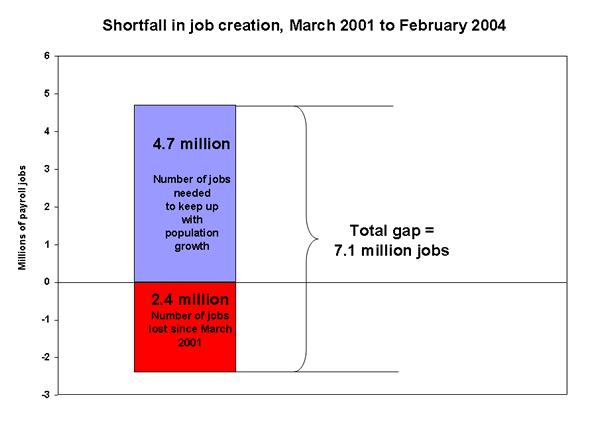See Snapshots Archive.
Snapshot for March 15, 2004.
Jobs fall behind growth in working-age population
The U.S. economy would have generated 7.1 million more payroll jobs if job gains had kept pace with the growth in the working-age population since the recession began in March 2001. The shortfall in job creation has two parts: 1) the 2.4 million job decline since the last peak in employment in March 2001 and 2) the 4.7 million jobs needed to keep up with the growth in the working-age population since that point.

The working-age population is growing by 1.2% a year. That reflects both the large numbers of young people who are reaching working age and the continuing net immigration. Had payroll jobs kept up with working-age population growth since March 2001, the economy would be adding 137,000 new jobs each month. Every month that payroll jobs grow by fewer than 137,000, the jobs gap widens. In the past six months, job growth has averaged only 61,000, with February 2004 showing a gain of just 21,000 new jobs (see JobWatch.org for a complete analysis of the February employment numbers). As a result, the jobs gap keeps widening.
Some have tried to rationalize the current low levels of job creation by arguing that there were too many jobs in March 2001. However, that argument does not make economic sense because March 2001 was a time of both low inflation and strong productivity. The bottom line is that, as the growth in the working-age population outpaces job growth, there are fewer employment opportunities for the growing number of people expected in the job market.
The number of payroll jobs reached a low point six months ago, in August 2003. Job growth has averaged only 61,000 a month in the last six months—far less than the 137,000 jobs a month now required to keep the jobs gap from widening. As a result, despite positive job gains, the jobs gap has grown from 6.6 million last August to 7.1 million in February 2004.
Source: EPI analysis of Bureau of Labor Statistics data.
This week’s snapshot was written by EPI Research Director Lee Price.
